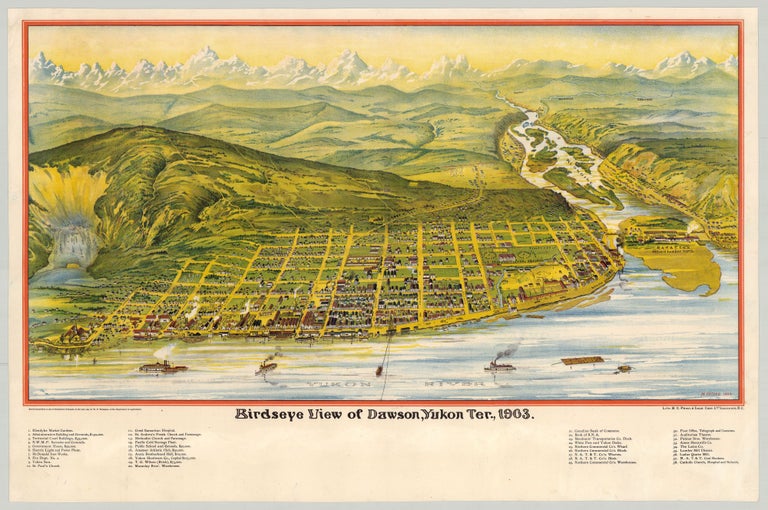Birdseye View of Dawson, Yukon Ter., 1903.
Vancouver, British Columbia: Print. & Engr Corp Ltd., 1903. Chromolithograph, 19” x 35.5” plus margins. CONDITION: Very good, expertly repaired tear through right side of title and just into image and extending to left in the river, small repaired loss between the words “Yukon” and “River” just above title, a few other short repaired tears, light soiling to margins, recently backed with Japanese tissue. A splendid chromolithographic view of Dawson, Yukon Territory, published shortly after the height of the Klondike Gold Rush and just a year before the town’s incorporation. This richly-detailed view shows Dawson as seen from an elevated position above the west bank of the Yukon River, and spans from the Dawson Landslide on the left to Klondike City on the right. The Klondike River appears in the foreground, then turns and extends eastwards towards the snow-covered Ogilvie Mountains in the distance. Steamboats, rafts and flatboats ply the waters of the river, including a cable-drawn ferry shown as it crosses from the west bank to Dawson, with the associated cable tower visible on the city shoreline. A key below the image identifies nearly forty buildings in the town, including the Barracks and Grounds of the North-West Mounted Police, the Electric Light and Power Plant, the Public School and Grounds, numerous warehouses, stores, governmental and religious buildings, and even an Amateur Athletic Club. The cost of construction of several buildings is noted as well as the current capital of several businesses. The dominant hue of this handsome chromolithograph is yellowish-gold, almost as if intended to suggest the wealth extracted from the region and giving it an appealing glow. The region of Dawson was originally an important camp and gathering point for the Tr’ondëk Hwëch’in First Nation, but in 1896 became the booming center of the Klondike Gold Rush. The gold mining town was founded in 1897 (named for geologist George M. Dawson who had mapped the region ten years earlier), and by 1898 its population had climbed to near 30,000. By 1903, when this view was published, the population had fallen to about 7,000 and the town had “settled into a less chaotic life” (Reps). Henry Epting (1860–1911), called “one of the greatest color artists on the Pacific Coast” (“Portland Artist”) was the first staff artist at the West Shore magazine in the 1880s, and in 1886 was a founding member of the Portland Art Club, the first Pacific Northwest artist organization, to which African American artist and lithographer Grafton Tyler Brown also belonged. Epting made visits to Alaska, Montana, Idaho, and Yellowstone Park, and later settled in Oregon, where he worked for Gibson Catlett (1866–1935), known for his large-scale birdseye views. “By disposition morose and melancholy,” Epting died by suicide in Oregon. A marvelous view of this important Yukon gold rush town. REFERENCES: Cleaver, J. D. “L. Samuel and the ‘West Shore’: Images of a Changing Pacific Northwest,” Oregon Historical Quarterly, Vol. 94, No. 2/3 (1993); “Portland Artist Ends Life,” The Los Angeles Times, 13 March 1911; John Reps, Bird’s Eye Views, p.87; “San Francisco Man A Suicide in Portland,” The San Francisco Examiner, 13 March 1911, p. 2.
Item #7767
Sold


